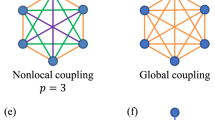Abstract
By using asymptotic theory, we generalise the Turing diffusively-driven instability conditions for reaction-diffusion systems with slow, isotropic domain growth. There are two fundamental biological differences between the Turing conditions on fixed and growing domains, namely: (i) we need not enforce cross nor pure kinetic conditions and (ii) the restriction to activator-inhibitor kinetics to induce pattern formation on a growing biological system is no longer a requirement. Our theoretical findings are confirmed and reinforced by numerical simulations for the special cases of isotropic linear, exponential and logistic growth profiles. In particular we illustrate an example of a reaction-diffusion system which cannot exhibit a diffusively-driven instability on a fixed domain but is unstable in the presence of slow growth.
Similar content being viewed by others
References
Castets V, Dulos E, Boissonade J, De Kepper P (1990) Experimental evidence of a sustained Turing–type equilibrium chemical pattern. Phys Rev Lett 64(3): 2953–2956
Chaplain M, Ganesh AJ, Graham IG (2001) Spatio-temporal pattern formation on spherical surfaces: numerical simulation and application to solid tumor growth. J Math Biol 42: 387–423
Connell McCluskey C (2005) A strategy for constructing Lyapunov functions for non-autonomous linear differential equations. Linear Algebra Appl 409: 100–110
Crampin EJ, Gaffney EA, Maini PK (1999) Reaction and diffusion on growing domains: scenarios for robust pattern formation. Bull Math Biol 61: 1093–1120
Crampin EJ, Gaffney EA, Maini PK (2002) Mode doubling and tripling in reaction-diffusion patterns on growing domains: a piecewise linear model. J Math Biol 44: 107–128
Crampin EJ, Hackborn WW, Maini PK (2002) Pattern formation in reaction-diffusion models with nonuniform domain growth. Bull Math Biol 64: 746–769
Edelstein-Keshet L (1988) Mathematical models in biology. Random House, New York
Gierer A, Meinhardt H (1972) A theory of biological pattern formation. Kybernetik 12: 30–39
Gjorgjieva J, Jacobsen J (2007) Turing patterns on growing spheres: the exponential case. Dynamical systems and differential equations. In: Proceedings of the 6th AIMS international conference. Discrete continuous dynamical systems supplement, USA, pp 436–445
Golub GH, Van Loan CF (1996) Matrix computations. JHU Press ISBN 0801854148
Kondo S, Asai R (1995) A reaction-diffusion wave on the skin of the marine anglefish, Pomacanthus. Nature 376: 765–768
Liaw SS, Yang CC, Liu RT, Hong JT (2001) Turing model patterns of lady beetles. Phys Rev E 64: 041909
Madzvamuse A (2005) Time-stepping schemes for moving grid finite elements applied to reaction-diffusion systems on fixed and growing domains. J Comp Phys 24(1): 239–263
Madzvamuse A (2008) Stability analysis of reaction-diffusion systems with constant coefficients on growing domains. Int J Dyn Diff Eq 1(4): 250–262
Madzvamuse A, Maini PK (2007) Velocity-induced numerical solutions of reaction-diffusion systems on fixed and growing domains. J Comp Phys 225: 100–119
Madzvamuse A, Maini PK, Wathen AJ (2003) A moving grid finite element method applied to a model biological pattern generator. J Comp Phys 190: 478–500
Madzvamuse A, Wathen AJ, Maini PK (2005) A moving grid finite element method for the simulation of pattern generation by Turing models on growing domains. J Sci Comp 24(2): 247–262
Maini PK, Crampin EJ, Madzvamuse A, Wathen AJ, Thomas RDK (2002) Implications of domain growth in morphogenesis. In: Capaso V (ed) Mathematical modelling and computing in biology and medicine. Proceedings of the 5th European conference for mathematics and theoretical biology: conference, Milan, vol 153, pp 67–73
Maini PK, Baker RE, Chong CM (2006) The Turing model comes of molecular age, (Invited Perspective). Science 314: 1397–1398
Murray JD (2002) Mathematical biology I and II, 3rd edn. Springer, Berlin
Oster AM, Bressloff PC (2006) A developmental model of ocular dominance column formation on a growing cortex. Bull Math Biol 68: 73–98
Ouyang Q, Swinney HL (1991) Transition from a uniform state to hexagonal and striped Turing patterns. Nature 352: 610–612
Painter KJ, Othmer HG, Maini PK (1999) Stripe formation in juvenile Pomacanthus explained by a generalized Turing mechanism with chemotaxis. Proc Natl Acad Sci 96: 5549
Plaza RG, Sánchez-Garduño F, Padilla P, Barrio RA, Maini PK (2004) The effect of growth and curvature on pattern formation. J Dynam Diff Equ 16(4): 1093–11214
Prigogine I, Lefever R (1968) Symmetry breaking instabilities in dissipative systems. II. J Chem Phys 48: 1695–1700
Schnakenberg J (1979) Simple chemical reaction systems with limit cycle behaviour. J Theor Biol 81: 389–400
Sick S, Reinker S, Timmer J, Schlake T (2006) WNT and DKK determine hair follicle spacing through a reaction-diffusion mechanism. Science 314: 1447–1450
Solnica-Krezel L (2003) Vertebrate development: taming the nodal waves. Curr Biol 13: R7-9
Turing A (1952) The chemical basis of morphogenesis. Phil Trans R Soc Lond B 237: 37–72
Varea C, Aragón JL, Barrio RA (1999) Confined Turing patterns in growing systems. Phys Rev E 60: 4588–4592
Author information
Authors and Affiliations
Corresponding author
Rights and permissions
About this article
Cite this article
Madzvamuse, A., Gaffney, E.A. & Maini, P.K. Stability analysis of non-autonomous reaction-diffusion systems: the effects of growing domains. J. Math. Biol. 61, 133–164 (2010). https://doi.org/10.1007/s00285-009-0293-4
Received:
Revised:
Published:
Issue Date:
DOI: https://doi.org/10.1007/s00285-009-0293-4
Keywords
- Convection-reaction-diffusion systems
- Turing diffusively-driven instability
- Pattern formation
- Growing domains asymptotic theory
- Domain-induced diffusively-driven instability




